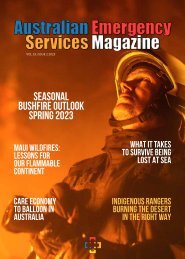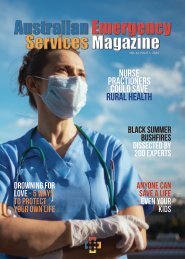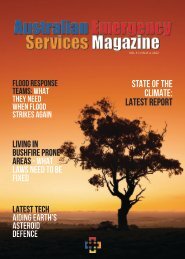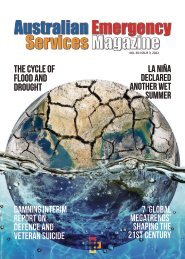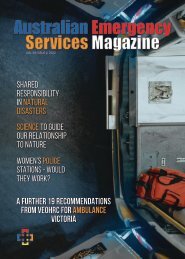AESM Vol 22 Edition 1 2021
The latest Australian Emergency Services Magazine Vol 22 Issue 1 2021. The latest in emergency services news and events. Regular columnists Associate Professor Erin-Cotter Smith, Paramedic and author Tammie Bullard and Dr Michael Eburn for all things Emergency Law. Bushfire Natural Hazards CRC on the Risks of Floodwater, Paramedic Rasa Piggott's open letter to the board of Ambulance Victoria and subsequent information regarding the independent inquiry and the anatomy of the recent Perth bushfire and how it differed to the Black Summer fires. Free to subscribe through the website www.ausemergencyservices.com.au
The latest Australian Emergency Services Magazine Vol 22 Issue 1 2021. The latest in emergency services news and events. Regular columnists Associate Professor Erin-Cotter Smith, Paramedic and author Tammie Bullard and Dr Michael Eburn for all things Emergency Law. Bushfire Natural Hazards CRC on the Risks of Floodwater, Paramedic Rasa Piggott's open letter to the board of Ambulance Victoria and subsequent information regarding the independent inquiry and the anatomy of the recent Perth bushfire and how it differed to the Black Summer fires. Free to subscribe through the website www.ausemergencyservices.com.au
Transform your PDFs into Flipbooks and boost your revenue!
Leverage SEO-optimized Flipbooks, powerful backlinks, and multimedia content to professionally showcase your products and significantly increase your reach.
had dwindled to just 133 people with a<br />
median age of 61.<br />
The town relies on agriculture and<br />
animal husbandry, but faces myriad<br />
challenges, including:<br />
• deteriorating Federation-era<br />
buildings, such as churches and<br />
community halls, with about 30%<br />
of houses unoccupied<br />
• poor transport infrastructure,<br />
including crumbling roads, only<br />
one bus stop, a bus that goes<br />
once a week to Bendigo<br />
• declining economic activity, with<br />
just one hotel, one post office and<br />
little to attract visitors<br />
• growing risk from storms,<br />
droughts and bushfires<br />
• a vulnerable population, with<br />
approximately 60-70% people<br />
living from pension to pension<br />
• limited access to health care<br />
facilities<br />
• insecure power and water<br />
infrastructure.<br />
The town is at risk of disappearing.<br />
Its people face real danger when fire,<br />
heatwaves or other natural hazards<br />
strike and there’s precious little<br />
disposable income to spend on futureproofing<br />
homes.<br />
The trajectory for Tarnagulla is not<br />
unusual in Victoria. Determined<br />
to save it from being engulfed by<br />
climate-change related disasters,<br />
the community applied for and got a<br />
grant from the Victorian Department<br />
of Environment, Land, Water and<br />
Planning, through their Virtual Centre<br />
for Climate Change Innovation.<br />
They used part of the money to<br />
engage one of the authors (Mittul<br />
Vahanvati), to co-produce a RAP for<br />
and by Tarnagulla community.<br />
Increasingly frequent and harsher<br />
heatwaves, bushfires and droughts<br />
We held eight workshops over two<br />
years in Tarnagulla, with project<br />
leaders from the local community<br />
meeting me (Mittul Vahanvati) monthly.<br />
Establishing mutual trust and a sense<br />
of collaborative design was crucial; the<br />
process doesn’t work when an outsider<br />
parachutes in and starts telling locals<br />
what to do.<br />
We identified the town’s existing<br />
strengths (outlined in the table below).<br />
We also talked about how climate<br />
change-related disasters — such as<br />
increasingly frequent and harsher<br />
heatwaves, bushfires and droughts —<br />
were causing problems locally such as<br />
• power outages becoming longer<br />
and more frequent<br />
• the soaring cost of keeping the<br />
house cool<br />
• concerns the dam might burst in<br />
a flood<br />
• people going without water for<br />
five days in previous disasters<br />
and being forced to buy water to<br />
survive.<br />
The resulting RAP identified five main<br />
goals. These can be seen in the table<br />
on the following page.<br />
Local councillors, and representatives<br />
from the emergency management<br />
sector and the health sector got<br />
together to test out the RAP, its<br />
feasibility and whether it would help<br />
reduce loss and devastation of town<br />
during hazards.<br />
It became clear a complete emergency<br />
evacuation plan would require<br />
the town having a safer shelter,<br />
improving key roads used to flee the<br />
town and ensuring comprehensive<br />
communication systems to help<br />
vulnerable people (such as older<br />
people, children or single people)<br />
during a disaster.<br />
The town also identified the need for<br />
www.ausemergencyservices.com.au 38




